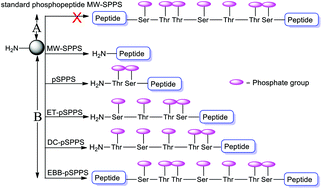A targeted approach for the synthesis of multi-phosphorylated peptides: a tool for studying the role of phosphorylation patterns in proteins†
Abstract
Protein phosphorylation barcodes, clusters of several phosphorylation sites within a short unfolded region, control many cellular processes. Existing biochemical methods used to study the roles of these barcodes suffer from low selectivity and provide only qualitative data. Chemically synthesized multiphosphopeptide libraries are selective and specific, but their synthesis is extremely difficult using the current peptide synthesis methods. Here we describe a new microwave assisted approach for synthesizing a library of multiphosphopeptides, using the C-terminus of rhodopsin as a proof of concept. Our approach utilizes multiple protocols for synthesizing libraries of multiphosphopeptides instead of the inefficient single protocol methods currently used. Using our approach we demonstrated the synthesis with up to seven phosphorylated amino acids, sometimes next to each other, an accomplishment that was impractical before. Synthesizing the Rhodopsin derived multiphosphopeptide library enabled dissecting the precise phosphorylation barcode required for the recruitment, activation and modulation of the conformation of Arrestin. Since phosphorylation barcodes modulate the activity of hundreds of GPCRs, synthesizing libraries of multiphosphopeptides is the method of choice for studying their molecular mechanisms of action. Our approach provides an invaluable tool for evaluating how protein phosphorylation barcodes regulate their activity.

- This article is part of the themed collection: Chemical Biology in OBC


 Please wait while we load your content...
Please wait while we load your content...